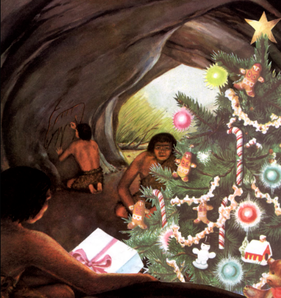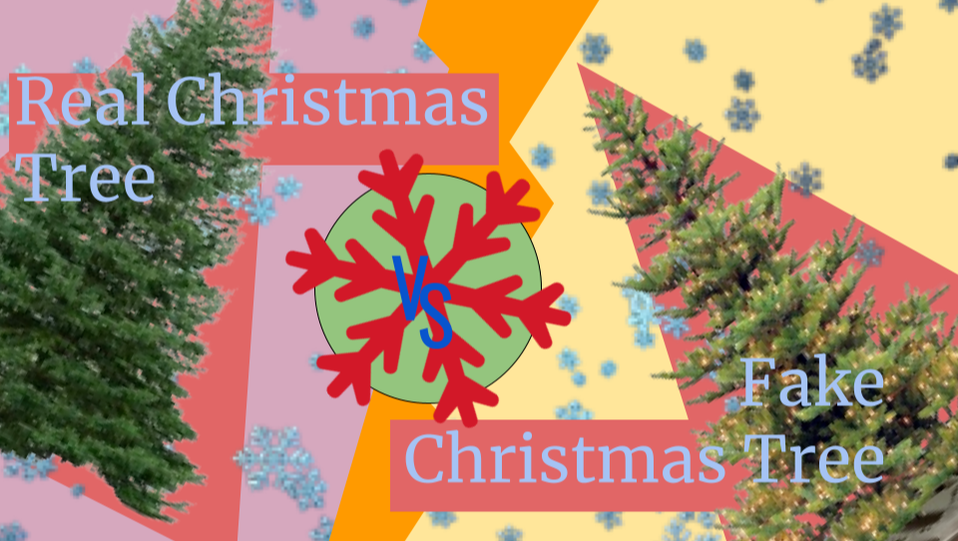"If you’re reading this you probably know about Christmas. The holiday that paved the way for movies, clothing, and a whole lot of traditions. One of the most popular of these traditions is the tree. but there’s always been an argument surrounding these evergreen legends. Real or Fake?" -- Elias Yuasa, 7th grade

If you’re reading this you probably know about Christmas. The holiday that paved the way for movies, clothing, and a whole lot of traditions. One of the most popular of these traditions is the tree. The fabled Christmas tree is an icon of the holiday that can be seen across cookies, living rooms, and even in Times Square—but there’s always been an argument surrounding these evergreen legends. Real or Fake?
A question older than plastic itself, one that has plagued our culture for decades. But which one is truly better? Is one better than the other? Who knows. They both have their pros and cons, but what are they?
Let's look at the benefits of the first tree to step into the ring, mr. fantastic plastic, the reasusable king: the mass produced fake tree. At the top of the well known benefits of fake trees is their reusability. While real trees can barely last through the holiday, these plastic greens can be reused for years. In addition to their easy reasusability, they’re also easier to decorate, with most having lights and other decor built in, making them incredibly convenient, according to the Washington Post.
But when it comes to carbon footprint, real trees have these fakers beat. The main problem with fake trees is that they’re made of plastic. Since the creation of plastic in 1907, there have been a multitude of problems with it, namely that it isn’t renewable and it leaves a huge carbon footprint. According to the Washington Post, most plastic trees are taken overseas in fossil-fuel burning freighters from China before being distributed to stores. The Post goes on to say that the making of the trees leaves an even bigger carbon footprint. If you're looking for sustainability, plastic isn’t your best choice.
A question older than plastic itself, one that has plagued our culture for decades. But which one is truly better? Is one better than the other? Who knows. They both have their pros and cons, but what are they?
Let's look at the benefits of the first tree to step into the ring, mr. fantastic plastic, the reasusable king: the mass produced fake tree. At the top of the well known benefits of fake trees is their reusability. While real trees can barely last through the holiday, these plastic greens can be reused for years. In addition to their easy reasusability, they’re also easier to decorate, with most having lights and other decor built in, making them incredibly convenient, according to the Washington Post.
But when it comes to carbon footprint, real trees have these fakers beat. The main problem with fake trees is that they’re made of plastic. Since the creation of plastic in 1907, there have been a multitude of problems with it, namely that it isn’t renewable and it leaves a huge carbon footprint. According to the Washington Post, most plastic trees are taken overseas in fossil-fuel burning freighters from China before being distributed to stores. The Post goes on to say that the making of the trees leaves an even bigger carbon footprint. If you're looking for sustainability, plastic isn’t your best choice.

But real trees aren’t all pros either, there are cons. As NPR reports that, “The environmental impact of Christmas tree farming is complicated and depends on factors like how far the trees are transported, how they're watered, and what kinds of fertilizers, herbicides and pesticides are used.” In some cases this can leave a worrying impact on our climate. Still nothing quite like plastic, but still worrying.
On the other hand, real trees, while still not amazing when it comes to climate change, are renewable and pale in comparison to fake trees. As the San Francisco Chronicle writes, “a natural tree is all natural.” Plus as Lit Arts 8th grader Poppy Zaiger says, “Fake trees are ugly and I like the smell of pine.” This only goes to show that a real tree looks a lot nicer in a living room than a plastic one—and it’ll smell better.
However, the convenience factor of real trees is rather horrible, having to spend sometimes hours looking for a tree and getting it home only to need to spend even more time decorating it. Neither tree is perfect, and at the end of the day it’s just personal preference.
On the other hand, real trees, while still not amazing when it comes to climate change, are renewable and pale in comparison to fake trees. As the San Francisco Chronicle writes, “a natural tree is all natural.” Plus as Lit Arts 8th grader Poppy Zaiger says, “Fake trees are ugly and I like the smell of pine.” This only goes to show that a real tree looks a lot nicer in a living room than a plastic one—and it’ll smell better.
However, the convenience factor of real trees is rather horrible, having to spend sometimes hours looking for a tree and getting it home only to need to spend even more time decorating it. Neither tree is perfect, and at the end of the day it’s just personal preference.


